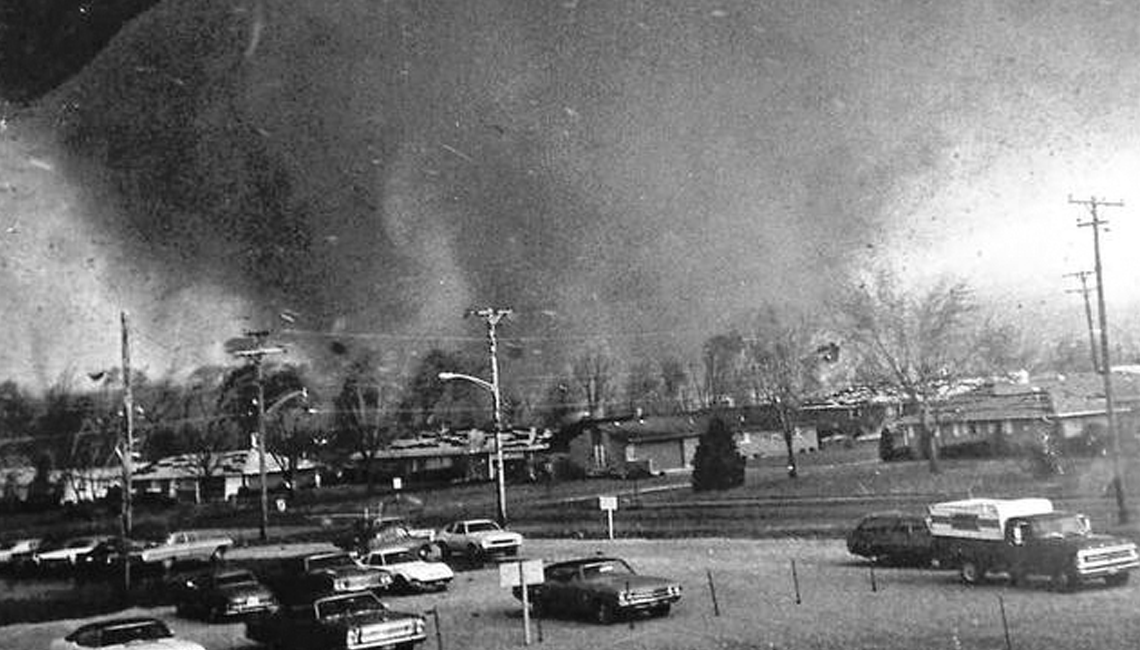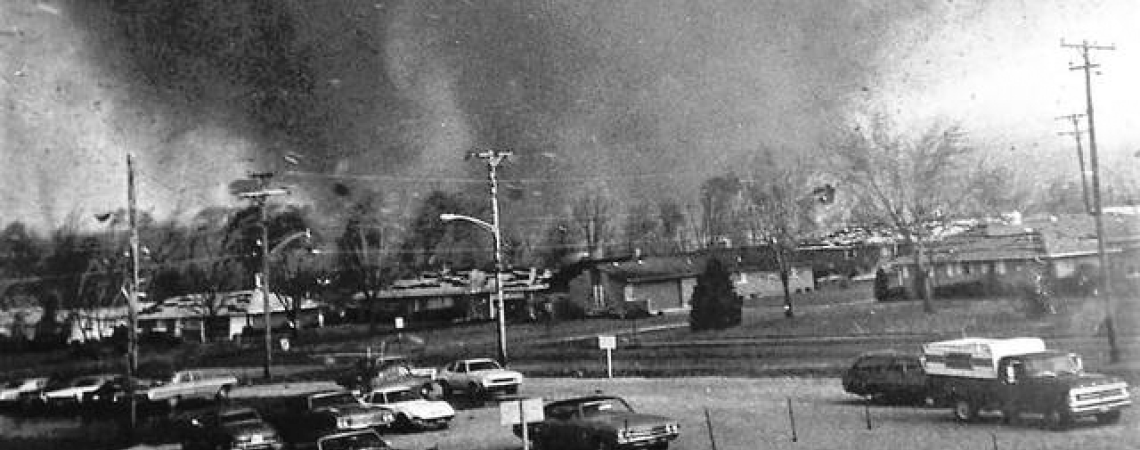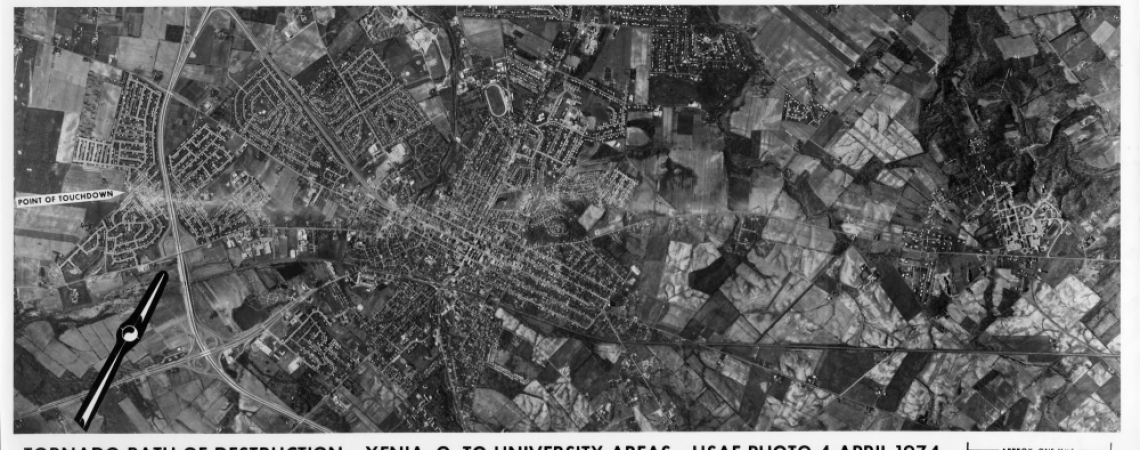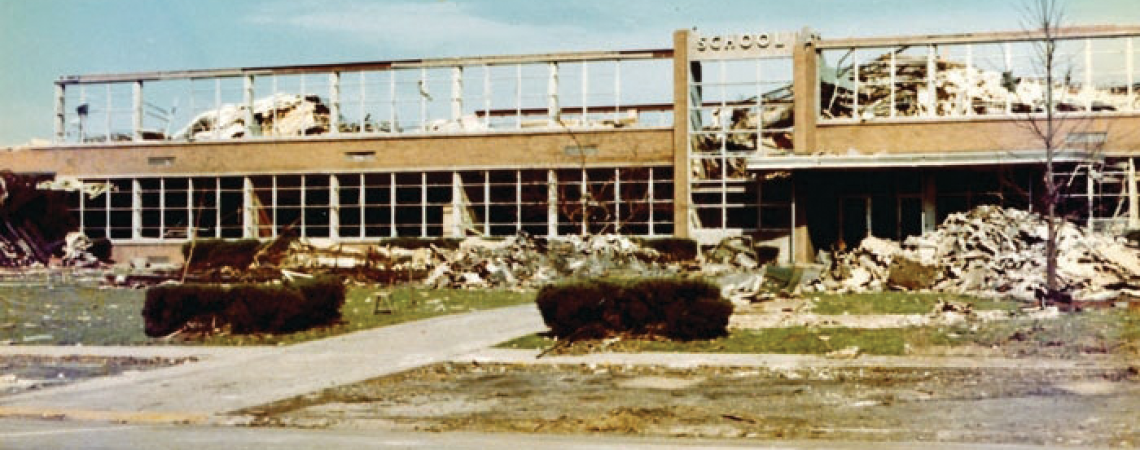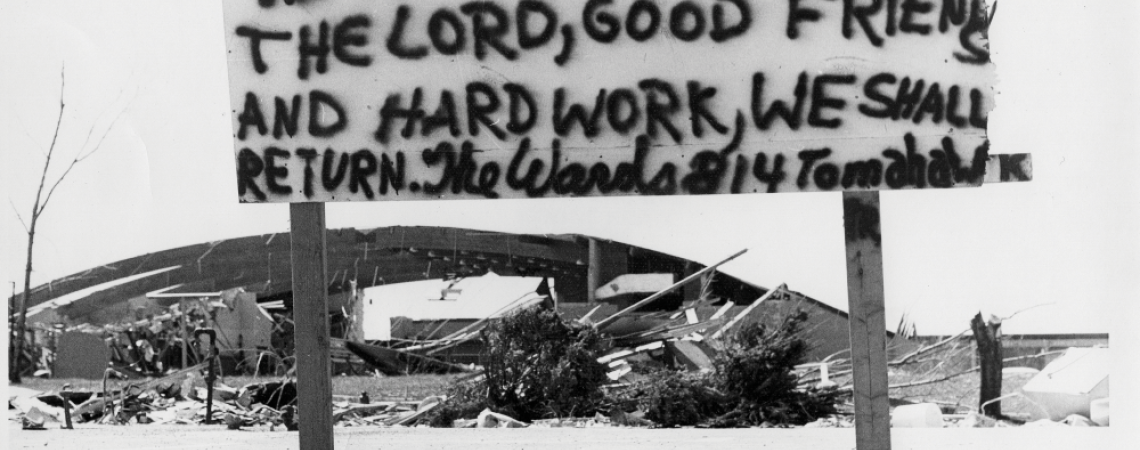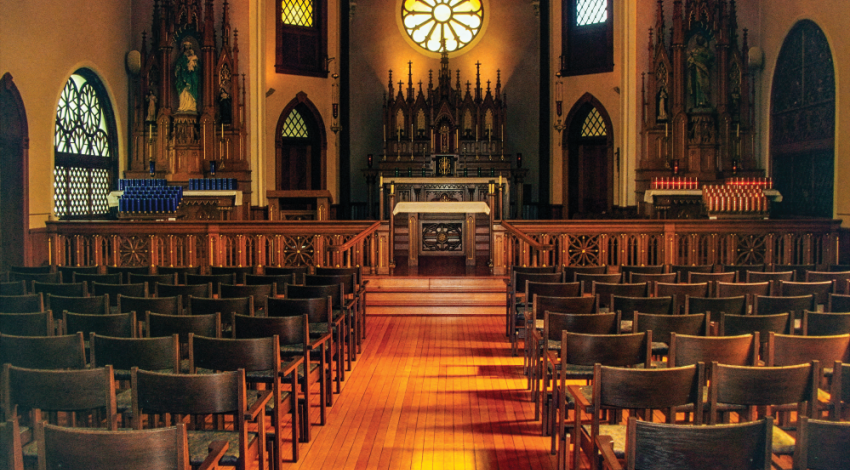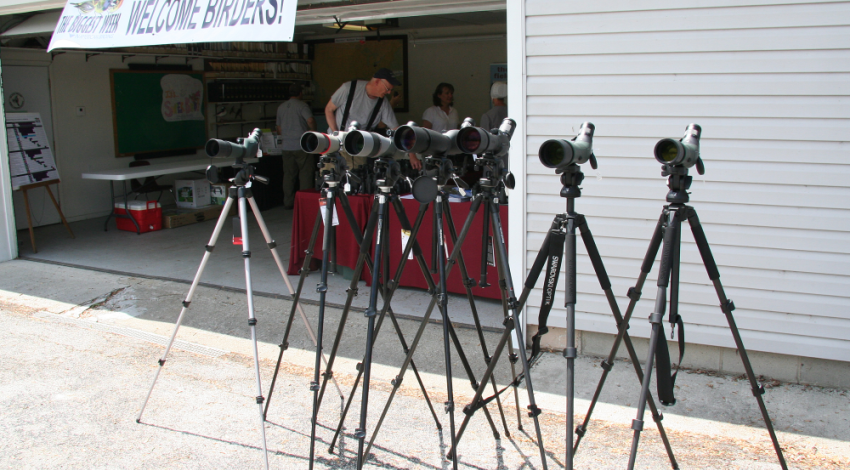On permanent exhibit at the Greene County Ohio Historical Society in Xenia is a tattered American flag that had been used to mark the slab foundation where a house had stood before the afternoon of April 3, 1974 — 50 years ago this month — when one of the most devastating tornadoes in U.S. history ripped Xenia apart.
Joyce Behnken, 22 years old and pregnant at the time, resided in that house in the Arrowhead subdivision where the tornado first unleashed its full fury; she died when the storm picked up her house and smashed it to bits.
Nearby in that same subdivision, Catherine Wilson rode out the storm huddled with her mother and sister in the bathtub of their Pueblo Drive home. Wilson was only 9, but she still remembers the terrifying gray cloud that boiled like a pot and sucked up everything in its path.
As the tornado barreled through Xenia, it reached a half-mile wide and packed winds exceeding 200 miles per hour.
“The tornado probably passed over our house in 30 seconds, but it seemed like forever,” says Wilson, now the director of the Greene County Historical Society. “We heard windows breaking and the roof being torn off. The tornado roared like a jet engine.” Her home sustained serious damage, but the tornado obliterated nearby houses and turned the neighborhood into a nightmarish scene. Familiar landmarks were gone. Debris was everywhere. Children cried and dazed adults sifted through shattered dwellings in hopes of salvaging belongings.
“I remember being what the British call ‘gobsmacked’ by what I saw,” Wilson says. “Downed trees looked like scattered sticks. A boat trailer was upside down, but the boat had disappeared.”
Xenia’s tornado was part of a “Super Outbreak” that stretched from Alabama to Ontario, Canada. An astounding 148 twisters — including an unprecedented seven F5 and 23 F4 tornadoes — touched down within 24 hours, killing more than 300 people. Fifty years later, it remains the benchmark for massive tornadic events.
“The Super Outbreak was the biggest one that our nation and possibly the world has ever seen,” says Andy Hatzos, a meteorologist and tornado forecaster at the National Weather Service office in Wilmington. “Leveling half the town, [Xenia’s] was the Super Outbreak’s deadliest tornado and made Xenia the unwilling but definitive symbol for that catastrophic weather event.”
Working just 20 miles south of Xenia, Hatzos knows all about the multi-vortex F5 monster that attacked the town of 25,000 at about 4:40 p.m. that day. “If I were doing a Mount Rushmore for tornadoes, Xenia’s would certainly be on it.”

The tornado touched down to the east and a bit north of Bellbrook and traveled 32 miles before dissipating near South Vienna in Clark County. As it barreled through Xenia, it reached a half-mile wide and packed winds exceeding 200 miles per hour.
In four ferocious minutes, it derailed a freight train; heaved a school bus into the high school’s auditorium; hurled a tractor-trailer onto a roof; and hammered a beloved landmark — the circa 1799 Galloway Log House that the great Shawnee leader Tecumseh had once visited. It damaged or destroyed 3,400 homes and 159 businesses.
Hundreds were injured, and 35 people, including Joyce Behnken, lost their lives. Among the others: 12 children; two National Guardsmen who were killed by a flash fire in a furniture store; Central State University freshman Lura Lee Hull, who was driving home when the tornado crushed her car; Clyde Hyatt, a World War II Marine, who died helping youngsters take cover; Johnnie Mott, who perished in her real estate office; and Paul and Sue Ann Wisecup, their 16-month-old daughter, Amy, and two waitresses who all were sheltering in a root beer stand that was demolished.
Xenia Daily Gazette reporter Rich Heiland pecked out his story for the next day’s edition by candlelight, on a manual typewriter, as rain dripped through the newspaper office’s fractured roof. The town had no electricity. The column was titled “We Should All Be Dead Today.” Now semi-retired, Heiland vividly recalls marveling that the tornado had spared the lives of his wife, infant son, and 5-year-old daughter.
The Heilands also lived in Arrowhead, and before leaving the newsroom to cover the tornado, Heiland had hastily called his wife and told her to get the children and lie down in the laundry room. After watching the tornado dismantle St. Brigid church, he feared the worst. “When I finally got to my house, it was a wreck, and I froze, thinking they were dead,” says Heiland. But then, “like seeing a ray of sunshine,” he heard his wife’s voice. The house had disintegrated around them, but they were unharmed.
Heiland drove his family to his parents’ home in Wilmington, then returned to Xenia to help look for casualties, but instead of finding bodies, he found survivors. “I saw all kinds of people who were determined to carry on, doing whatever needed to be done,” he says.
The city manager, not knowing whether his own loved ones were safe, commanded rescue and cleanup efforts. A café owner made coffee on a camp stove and gave it away. And the Gazette staff worked all night on tornado news that was rushed to Middletown and printed at a sister newspaper. On April 4, the Gazette’s front page declared, “Xenia Digging Out From Day of Horror.”
If the mind can fathom anything fortunate about a whirlwind violent enough to devastate nine of Xenia’s 12 schools, it certainly would be that the tornado struck an hour after 8,300 students were dismissed. With inexplicable serendipity, the tornado likewise both spared Xenia’s hospital and smashed its power plant. “Many destroyed houses had natural gas, and if electricity had been sparking, Xenia would have had terrible explosions and fires,” says Heiland.
Fourth-grader Ron Ward was lucky to not be at home when the tornado flattened the Tomahawk Trail house where he lived with his mom, Norine; dad, Duteil; and brother, Bill. A cousin had recently passed away, and Norine decided to briefly leave her sons at home while she took food to her aunt. She made it only as far as the corner before she turned around and fetched her boys. “But for the grace of God,” reflects Ward, “I would have died.” After they arrived at the aunt’s house on Second Street, someone spotted the tornado. All the relatives crowded into a bedroom and prayed. “I saw the front door get blown away and then just closed my eyes,” Ward says.
No one in the house was seriously hurt, but the structure was eventually condemned. In a cold rain and on streets strewn with hazards and debris, they walked to another family member’s house. Duteil, who had been working in Dayton, found them there hours later.
The Wards lost practically everything, and decided to tackle the rubble that was once their home by themselves. One day, Duteil gathered a piece of scrap plywood and some spray paint and made a sign that declared, “With the help of the Lord, good friends, and hard work, we shall return. The Wards.” With its simple statement of faith and purpose, that crude sign became an iconic representation of Xenia’s resolve to rebuild.
“My dad was not going to let a natural phenomenon beat us,” says Ward, “and that same attitude permeated the community.” Despite disagreements about redevelopment, people put “Xenia Lives” stickers everywhere. And the courthouse, the grand stone structure that has anchored Xenia since 1902 — battered, broken, and surrounded by ruin, but still standing — seemed to encourage residents to persevere.
“Xenia’s got plenty of heart,” Wilson says. “We all pulled together and supported each other.” Townspeople who worked for utility companies immediately got to work; Galliger’s Supper Club and Joe’s Diner provided thousands of free meals; folks with spare bedrooms took in strangers. Wilson’s father, who served with the Ohio Air National Guard in Springfield, protected Arrowhead from looters, and Ron Ward’s wife, Connie, remembers her dad helping board up neighbors’ windows.
Shortly after the tornado, President Richard Nixon helicoptered into Xenia for his only visit to a Super Outbreak site. Nixon remarked that its devastation was worse than anything he saw after Alaska’s earthquake or Hurricane Camille and promised federal aid. In December, entertainer Bob Hope hosted a benefit show at the University of Dayton Arena. With headliners like Debbie Reynolds and Nancy Wilson and appearances by Neil Armstrong, Johnny Bench, and Woody Hayes, it raised $100,000. Xenians gratefully named the auditorium in their new high school auditorium after Hope.
Xenia’s tornado had far-reaching repercussions. For his pioneering research on suction funnels and downbursts, Dr. Ted Fujita, who created the F-scale that ranks tornado intensity, analyzed a home movie of the tornado that 16-year-old Bruce Boyd made in his front yard on Ridgebury Drive. In 1975, the Xenia Daily Gazette staff received a Pulitzer Prize for spot news reporting.
Also, because the tornado made headlines everywhere, Xenians received attention they neither sought nor wanted. Ward, for example, spent 24 years in the Air Force at duty stations ranging from Korea to Germany, yet no matter where he went, the mere mention of Xenia elicited curiosity and questions about the tornado. “I tried explaining what happened,” says Ward, “but most people can’t wrap their heads around the devastation.”
Xenia once had the reputation as a railroad center; now, it’s known as the town that survived a legendary storm. After the tornado, Xenia’s once-ubiquitous railroad tracks gave way to trails, and it’s become both a bicycling hub and a place uniquely and forever reshaped by that ruthless event. Here and there, a street oddly ends in a stub. Blank spaces — mostly parking lots — linger where folks once lived and worked. On leafy Victorian-era streets, 1970s ranches and tri-levels incongruously coexist with handsome Italianate and Queen Anne houses. And when Xenia religiously tests its tornado sirens on the first Monday of every month, everyone in town heeds their cautionary wail.
The tornado also continues to affect people. Hatzos, who wasn’t born until the 1980s, gives talks about how and why it happened and often refers to a Super Outbreak map that Fujita made. “Xenia’s tornado is number 37 on the map, and Dr. Fujita’s hand-drawn F-scale figures show how quickly it gained strength.” After the Air Force, Ward and his wife came home to Xenia, and the family lore they share with their grandchildren includes Duteil’s sign and how the tornado demolished a relative’s home but left intact the new Harley that had been in the garage. When the bodies of the National Guardsmen who died in the fire were recovered, Heiland wept for the loss of life and the overwhelming loss in a town that began in 1803 as the Greene County seat. Later, some guardsmen who were leaving town gave him a key fob with the National Guard emblem. “That key fob is still on my keychain, and I carry it with me every day,” he says.
For Wilson, the tornado is part and parcel of her life and work. When the tornado’s notoriety brings visitors to the historical society, she shows them relics — that flag, a stained-glass window from St. Brigid church, the high school clock that stopped when the tornado hit — from the biggest thing that ever happened in Xenia. She also gives tours of the restored Galloway Log House, where a historical marker tells the story of a founding family and recounts the fateful day when death and destruction came to town. Its text concludes, “This marker stands directly in the path taken by the tornado and serves to remind us that ‘Xenia Lives.’”
